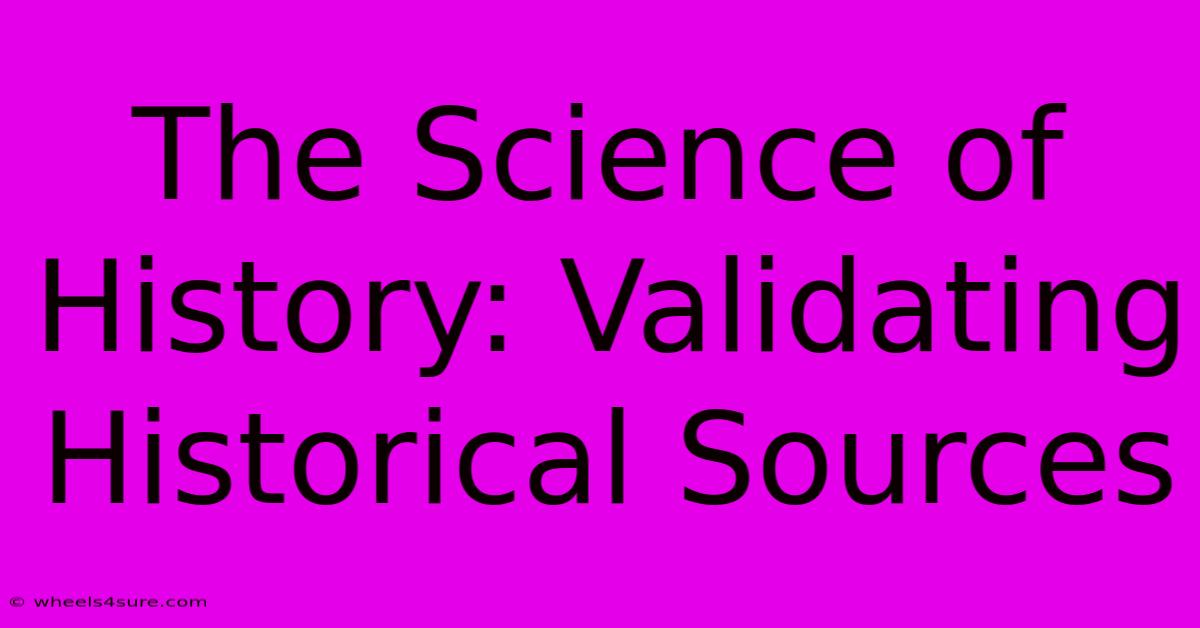The Science Of History: Validating Historical Sources

Table of Contents
The Science of History: Validating Historical Sources
History, often perceived as a narrative of the past, is fundamentally a scientific endeavor. Like any scientific discipline, it relies on rigorous methodology, particularly in the critical examination and validation of its sources. Understanding how historians assess the reliability and authenticity of historical sources is crucial to comprehending the construction and interpretation of historical narratives. This article delves into the scientific approach to validating historical sources, examining the techniques employed to ensure accuracy and avoid misleading conclusions.
The Foundation: Source Criticism
At the heart of historical research lies source criticism, a systematic process of evaluating the credibility of historical sources. This involves scrutinizing various aspects of the source to determine its authenticity, reliability, and potential biases. This isn't simply about accepting information at face value; it's about rigorously questioning its origins and context.
External Criticism: Authenticity and Origin
External criticism, also known as lower criticism, focuses on the physical aspects of a source. Historians analyze the source's physical characteristics to determine its authenticity and provenance. Questions asked include:
- Is the source genuine? Are there any signs of forgery or alteration? This involves examining handwriting, ink, paper type, and the materials used. Carbon dating or other scientific methods may be employed for older documents.
- Where and when was the source created? Pinpointing the source's origin helps contextualize its content and assess potential biases. This involves analyzing the language, script, and any identifying marks.
- Who created the source? Identifying the author (or creator) is critical. Their background, beliefs, and potential motivations heavily influence the information presented.
Internal Criticism: Reliability and Bias
Internal criticism, or higher criticism, delves into the content of the source itself. Historians evaluate the accuracy, reliability, and potential biases embedded within the information presented. This involves:
- Analyzing the author's perspective: What are the author's biases, beliefs, and intentions? How might these influence their account of events? Understanding the author's context is key to interpreting their work objectively.
- Comparing multiple sources: Corroboration is crucial. Historians compare information from various sources to identify consistencies and discrepancies. Discrepancies don't automatically invalidate a source, but they require careful analysis and explanation.
- Considering the context of creation: Understanding the historical circumstances surrounding the creation of the source is vital. This includes political, social, and cultural factors that might have influenced the content.
Types of Historical Sources
Historians utilize various types of sources, each requiring specific forms of critical analysis:
- Primary Sources: These sources are created during the period being studied and offer firsthand accounts. Examples include letters, diaries, official documents, and artifacts.
- Secondary Sources: These sources interpret and analyze primary sources. Examples include textbooks, scholarly articles, and biographies.
Beyond Source Criticism: Contextualization and Interpretation
Validating historical sources isn't simply a matter of verifying authenticity and reliability. It also involves:
- Contextualization: Placing the source within its broader historical, social, and cultural context.
- Interpretation: Analyzing the meaning and significance of the source within its context.
Conclusion: The Ongoing Scientific Process
The validation of historical sources is a continuous process of critical inquiry. It is not a simple matter of accepting or rejecting information, but rather of carefully weighing the evidence, considering potential biases, and developing nuanced interpretations based on rigorous methodology. By employing the principles of source criticism and contextual analysis, historians strive to construct accurate and insightful narratives of the past. The ongoing nature of historical research reflects the scientific pursuit of truth and the constant refinement of our understanding of the past.

Thank you for visiting our website wich cover about The Science Of History: Validating Historical Sources. We hope the information provided has been useful to you. Feel free to contact us if you have any questions or need further assistance. See you next time and dont miss to bookmark.
Featured Posts
-
Age Of Empires 3 Hile Is It Bannable
Apr 13, 2025
-
Rahul Gandhis Age Ready To Lead India
Apr 13, 2025
-
Maximize Your Walnut Intake 100 Grams Guide
Apr 13, 2025
-
Shamea Mortons Net Worth Fact Vs Fiction
Apr 13, 2025
-
Brian Littrells Son A Star Is Born
Apr 13, 2025
